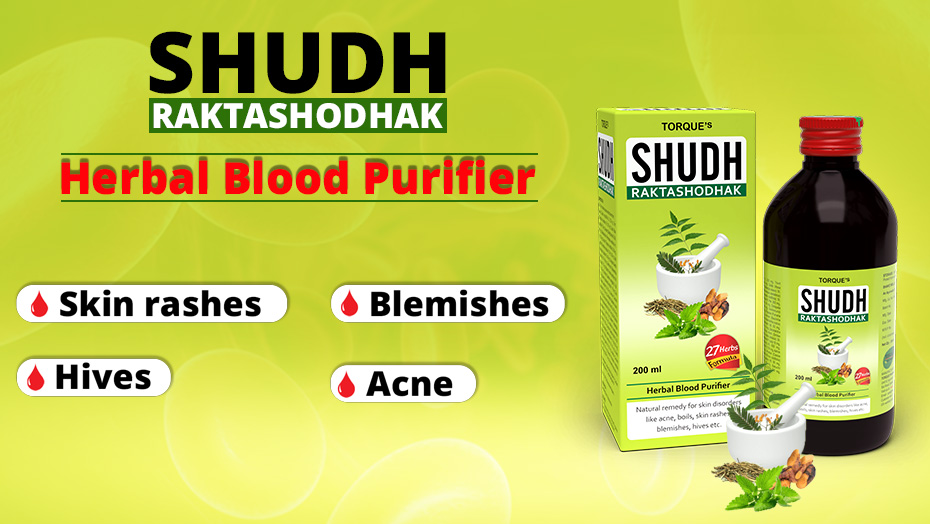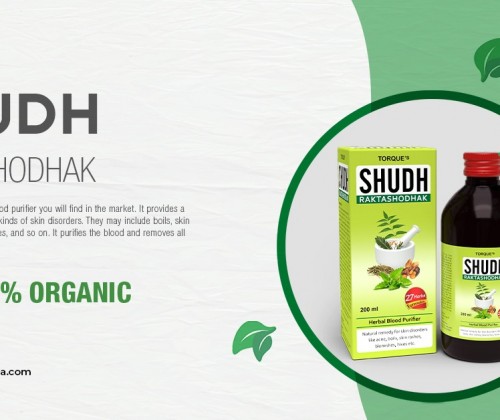

Simple Ways To Remove Blemishes Of The Skin With Ayurvedic Shudh Raktashodhak
Any type of mark, stain, discoloration, or defect that occurs on the skin is known as a blemish. Blemishes on the face may be emotionally disturbing, but most of them are benign, not life-threatening. The search for medical treatment or the use of at-home remedies can help to reduce blemishes. But a clean flow of blood and blood free of any toxins helps to maintain the skin even better.
Skin clarity is due to healthy and clean red blood vessels that are vital for skin-related cases and pimples. It also helps maintain the quality of the skin along with its texture, since the red blood cells help to transport oxygen. This can be achieved by purifying the blood regularly by consuming ayurvedic Shudh Raktashodhak syrup.
Blemish “is a broad term referring to any skin mark. There are many types of blemishes.
Acne
Acne is an all too common condition. Acne can show up as:
- pimples
- blackheads
- whiteheads
Acne is caused when hair follicles are clogged with sebum (oil), bacteria, or dirt. Sometimes acne can leave dark spots, scars, or skin scarring. Hormonal shifts are known to play a part in acne formation. Stress can also make acne worse by increasing sebum output, but this disorder is not considered a root cause.
Papules
Papules are small and varying types of skin lesions that usually have a diameter of about 1 centimeter. They can vary from Rosie to brown in color. Pimples are sometimes termed papules. Papules can occur either individually or in clusters, and they can be any type.
Nodules
The nodules are a tissue array. They are more significant than papules to the eye, usually 1 to 2 centimeters in diameter. Nodules can occur at any skin level and can range from flesh-toned to red. Skin tags are examples of nodules and warts.
Age spots
In any part of the body that has been exposed to the sun, these tiny, dark spots will form. They are most common in people over 50 but can occur in younger people as well. An age spot is a kind of hyperpigmentation.
Pustules
Pustules are bumps filled with fluid, or pus. Groups of pustules are the whiteheads and chickenpox blisters. Other conditions that could lead to the formation of pustules include scabies and rosacea, a common skin condition.
Scars
The scarring of the skin occurs when damage is done to the dermis layer. The dermis is the deep skin layer, where there are small blood vessels, sweat glands, hair follicles, and nerve endings. Anything that causes the skin to open, like a wound or popped pimples can lead to scarring.
What is causing the blemishes?
- Virus– Viruses such as HSV-1 cause some blemishes, like cold sores. Chickenpox is caused by the Varicella-zoster virus (VZV).
- Infections – Some types of skin infections can cause the skin to erupt with blemishes. These include Malassezia folliculitis (the fungal acne), a hair follicle infection. This condition is due to the overgrowth of yeast and results in the formation of pustules.
- Genetics– Acne can be genetically linked. Besides, certain genetic conditions can cause blemishes. Acne can be genetically linked. Moreover, certain genetic conditions can cause blemishes.
- Exposure to the sun– Over-exposure to the harmful ultraviolet ( UV) rays from the sun can cause skin cancer, hyperpigmentation, and other skin damage.
- Clogged pores– Overproduction of oil can cause blemishes by the sebaceous glands. This overproduction is often triggered by hormonal changes, like puberty. Excess oil can mingle with cells of dead skin, soil, or bacteria, which results in the development of pimples, pustules, blackheads, and whiteheads. Pores can get clogged with items like cosmetics, sunscreen, or moisturizers. Look for the non-comedogenic stuff.
- Nutrition –What you eat could impact your skin. Allergies to food and contact dermatitis can irritate the skin, as well as bumps. Dairy products, including skim milk, can in some people cause acne. Diets that are high in sugar content and simple carbohydrates can lead to defects, too.
No matter what the cause for blemishes could be, purifying the blood can heal all the skin issues. Your blood is responsible for carrying all manner of materials from oxygen to hormones, clotting agents, carbohydrates, fats, and the cells of your immune system in your body. There’s no need to invest in a costly cleanse diet or purchase tons of detox to keep your blood clean, free of toxins, and waste. Your liver and kidneys are already doing a great job of purifying your blood by removing waste and breaking it down. So, naturally, your best bet to cleanse your blood would be to find ways to help these essential organs function most effectively.
Consuming tonic for blood purification can be one of the effective ways to keep the organs function properly and the removal toxins from the body. Shudh Raktashodhak is one of the best blood purifier made of amazing ayurvedic herbs like,
Gorkhmundi: Gorakhmundi is believed to act as an excellent purifier for the blood to remove wastes from the body.
Pitpapra: Dried and powdered it can be taken twice a day for two weeks with water which helps purify the blood.
Kachnar: This tree’s bitter taste flowers are a natural purifier of blood and help expel extra toxins and body waste.
Haritaki: Haritaki is a remarkable herb with unique effects, and this one herb is used to cure various body-related disorders.
Share: It functions as an anti-inflammatory agent on your body.
Neem: The consumption of neem leaves or powder stimulates the increase of the metabolism of the kidneys and liver and eliminates the toxins. It is the best natural herb for blood cleaning and used as a purifier for blood. It functions as an antioxidant, which is used to improve the body’s immune system.
Bakuchi: This plant is a purifier of the natural blood. It is used to boost the blood detoxification process and the immune system. This plant’s seeds are used to treat complicated skin disorders. It also used to cure worm infestation
Tulsi: Highly beneficial for autoimmune diseases. It acts as a detoxifier and antioxidant.
Chirayata: Chirayata helps the body build more blood. This plant can be used to treat anemia. Chirayata is the best friend in the skins. Its antioxidant properties help clear the skin.
Babool: it acts as a detoxifier. It is the best herb for handling both internal and external health problems.
Kola: Helps reduce inflammation, stimulate the immune system, improve gastrointestinal health, and increase antioxidant capacity.
Satavari: This herb helps keep the energy levels healthy and strengthens the body. It is rich in natural antioxidants which helps with detoxification.
Guduchi: Guduchi assists to boost the immune system. This helps eliminate extra body toxins, rejuvenates the body, and also helps keep a balance between all of the body’s significant ailments. The herb helps prevent diseases from harming the body and maintains overall health.
Skin health often mirrors the degree of toxicity in the body. The skin is the largest organ in the body, and the elimination of toxins is one of its primary functions. If the body has an excess of toxins, the skin must deal with it, which results in signs of diminished vitality in the skin. By consuming Shudh Raktashodhak regularly, it not only cleanses your blood but also improves body metabolism.

